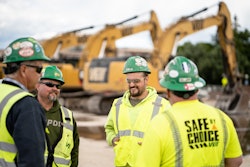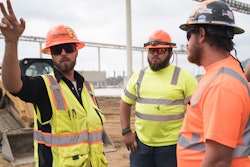
As the construction industry continues to struggle to find enough workers, contractors are increasingly looking to new ways – or ramping up traditional ones – to attract and keep employees.
A recent survey by the Associated General Contractors showed 93% of responding firms have job openings, and 91% are having trouble filling at least some of those slots. And with a construction industry unemployment rate of 3.9% and a national rate of 3.7%, construction companies are facing increased competition for any workers out there. AGC and other industry groups say that will only lead to more project delays and more hurdles to fixing the country’s infrastructure and ramping up U.S. semiconductor production.
“There's plenty of work for the industry to perform,” says AGC Chief Economist Ken Simonson. “Unfortunately, there aren't enough people to do the work needed to finish projects.”
More contractors are raising pay and benefits, but they’re also getting more involved in recruiting at schools and going out of state. Some have also reported success with hiring former prisoners.
‘Hiring in all positions’
Florida is seeing explosive residential construction as well as large municipal projects, says Stephen Sines, vice president of operations for The Morganti Group’s Southeast Office. All of that is increasing the hiring struggles.
“Morganti is currently hiring in all positions,” Sines said during a webinar August 31 to release AGC’s 2022 workforce survey results.
“When I speak to our subcontractors, they're in that same scenario. They also report that the higher level of skillset required for that position makes it more challenging for them to fill.”
To set itself above the competition for workers, Morganti has been capitalizing on the Sunshine State’s desirability by recruiting candidates from out of state. It is also broadening its recruitment at colleges and universities. “Historically, we have focused on degrees in building, construction and engineering, and now we have expanded that to accounting as well as business administration.”
The other main focus has been an internal one.
“We're really focused on having that high-quality work environment,” he said. “And what that does for us is it leads to more internal referrals of good candidates. That's not only economical, but it's also proven to be the more effective way to recruit construction workers.”
‘We’ve actually lost people to the housing industry’
Lithko Contracting’s branch in Oklahoma City has also been going out of state to find workers, said Brandon Bull, area lead.
“We've seen tremendous growth in every market category that we have in Oklahoma,” he said. “That's caused dramatic competition for craft (workers) in general.”
He reports that the self-perform concrete-structures construction company has faced unusually stiff competition for workers from residential construction.
“For the first time since I've been around, we've actually lost people to the housing industry, which has never happened before,” he said. “People are going out and doing concrete driveways and patios and charging three times what they were charging two years before.”
Some of the most difficult positions to fill have been for concrete finishers, rod busters, rebar workers and carpenters.
Along with going out of state, the company has hired recruiters dedicated specifically to craft workers. It has also created a talent development team for attracting and retaining management candidates. “We have taken some of our best talent on structural decks or specialty floors and pulled them out of the project management and operations world and brought them into the educators’ world,” he said.
It has also boosted pay and is working with AGC of Oklahoma to recruit at schools, colleges and universities, as well as career and vocational technical schools. “We’re trying all kinds of different things with them to find out what really sticks and what really adds the most value to the upcoming generation.”
Looking to former prisoners
Lithko has looked to former prisoners who are re-entering the workforce, and it’s seen some successes, Bull says.
Other contractors have, too.
“I've hired a couple of young ladies that have been incarcerated,” said LaTasha McCall, owner of LM2 Construction in Kansas City, Missouri. “I've had great success on it. The training and stuff that we've given them has just been amazing. I've had more success with the women and the men that have been incarcerated versus the people that we hire right out of high school.”
{For tips on hiring ex-prisoners, check out: Would You Hire a Former Prisoner at Your Construction Business?}
Foreign workers sought
The discussion also touched on immigration and the hiring of foreign workers on temporary visas as a help, but the current laws and red tape need overhauling, they said.
“When you talk about immigration reform, it's my opinion that any any type of reform would be better for the country, as well as the construction industry, compared to what we've had the last 25 years,” Sines said. “So there has to be a starting point somewhere.”
Cheryl Stewart, executive director of the Inland Northwest AGC in Washington, called for expansion of the H-2B visa program and approving those workers faster.
“We have several contractors who bring in seasonal workers,” she said. “This year, it was very delayed. They didn't come in until July, and we're halfway through our season at that point. So not only an expansion of that, but ensuring the timeliness of those workers.”
AGC Chief Economist Ken Simonson said the construction industry, as well as many other economic sectors, have historically relied on foreign-born workers to come to the country temporarily under the H-1B and H-2B programs, but that pipeline has slowed in the past three years.
“The federal government could revert to allowing more people in,” he said, “particularly if they're screened first and if a contractor can demonstrate the need to fill that position, that they have made good faith efforts to find workers in the domestic market and have not been able to in a reasonable period of time.
“It's clear that construction would benefit, as would many other industries.”
What the survey says
Here are highlights from AGC’s 2022 Workforce Survey of contractors:
- 93% of firms report that they have open positions they are trying to fill.
- 91% are having trouble filling at least some of those positions, particularly among the craft workforce.
- 86% of firms have raised base pay rates for their workers in past 12 months. That’s up from 73% in last year’s survey.
- 51% of survey respondents report they've engaged with career building programs such as high school, college or technical school construction programs. That's up from 37% in last year's survey.
- 47% of firms are boosting spending on training and professional development programs.
- 45% are providing incentives and bonuses. That’s up from 2021’s 34 percent.
- 39% increased online recruiting, such as Instagram Live, to connect with younger applicants. That’s up from about 33% in 2021.
- 32% used an executive search firm. That’s up from 26% in 2021.
- 30% used a craft staffing firm.
- 29% used software to distribute job postings and manage applicants. That’s up from 24% in 2021.
- 28% engaged with government workforce development or unemployment agencies to find workers. That’s up from 26% in 2021.
- 25% are enhancing their online and video training capabilities.
- 24% have improved their benefits packages. That’s up from 19% in 2021.
- 22% added or increased use of unions or of subcontractors or specialty contractors. That’s about the same percentage as last year.
- 16% are using augmented- and virtual-reality technology to better train workers. Last year it was 17%.
- 6% applied for employment-based visas, such as H-1B or H-2B. That’s up from 3% in 2021.











